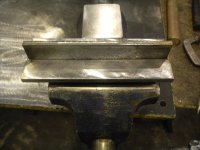You are using an out of date browser. It may not display this or other websites correctly.
You should upgrade or use an alternative browser.
You should upgrade or use an alternative browser.
How hard is TIG to learn
- Thread starter handirifle
- Start date
/ How hard is TIG to learn
#31
IslandTractor
Super Star Member
- Joined
- Sep 15, 2005
- Messages
- 17,101
- Location
- Prudence Island, RI
- Tractor
- 2007 Kioti DK40se HST, Woods BH
During my welding class I spent most of my time with a Miller 210 trying to make MIG welds that didn't resemble bird excrement. One day the instructor hooked up a Millermatic 350 and let us play with spray transfer. LOVED IT!!! Makes a novice look like a journeyman welder in about two minutes. Of course weld appearance isn't everything but boy does spray transfer look nice.
IslandTractor
Super Star Member
- Joined
- Sep 15, 2005
- Messages
- 17,101
- Location
- Prudence Island, RI
- Tractor
- 2007 Kioti DK40se HST, Woods BH
Anything is easier than stick!On my opinion it's easier than stick welding.
Only advantages of stick are that it involves less expensive welder and has a wide range of uses but it's harder to master than the others.
pmsmechanic
Elite Member
- Joined
- Dec 6, 2013
- Messages
- 4,043
- Location
- Southern Alberta, Canada
- Tractor
- 4410 and F-935 John Deere, MF 245
Now I'm learning stuff again. I just never even thought about welding copper. Subscribed.
Mark @ Everlast
Advertiser
Anything is easier than stick!
Only advantages of stick are that it involves less expensive welder and has a wide range of uses but it's harder to master than the others.
There are many advantages.
Stick isn't hard, not really. But it is the reason NO one should learn anything before they learn how to stick weld, and before that how to oxy/acetylene weld. Imho.
dragoneggs
Super Star Member
- Joined
- Jun 9, 2013
- Messages
- 14,617
- Location
- Seabeck, Washington
- Tractor
- Kubota BX-25D, Kubota Z122RKW-42
I truly appreciate where you are coming from. I will have to say though, it is MIG and the affordable technology that got me back into welding as a hobby/DIYer. I was exposed to (can't say learned) stick and O/A methods in college but probably wouldn't have picked it up again, sad to say, because of the quicker to success using MIG and the internet to help teach me.There are many advantages.
Stick isn't hard, not really. But it is the reason NO one should learn anything before they learn how to stick weld, and before that how to oxy/acetylene weld. Imho.
IslandTractor
Super Star Member
- Joined
- Sep 15, 2005
- Messages
- 17,101
- Location
- Prudence Island, RI
- Tractor
- 2007 Kioti DK40se HST, Woods BH
I started with Oxy/acetylene which I still I find to be the simplest and most basic. Easiest puddle to see and control. I enjoy it. Although I learned TIG last I find it very similar to oxyfuel in that it is very controllable. No smoke. Easy to see and control the puddle and with practice feeding filler isn't too hard. While MIG is pretty simple I find smoke and seeing puddle clearly can be a challenge. I can't dispute that stick should be taught before MIG/TIG, but I find it the hardest. Smoke and a long rod that is relatively hard to control precisely with stinger make stick the hardest for me. No doubt it is a vital skill to learn but in my case it has been frustrating.There are many advantages. Stick isn't hard, not really. But it is the reason NO one should learn anything before they learn how to stick weld, and before that how to oxy/acetylene weld. Imho.
Gary Fowler
Super Star Member
- Joined
- Jun 23, 2008
- Messages
- 11,998
- Location
- Bismarck Arkansas
- Tractor
- 2009 Kubota RTV 900, 2009 Kubota B26 TLB & 2010 model LS P7010
As a former welder, welding instructor and quality assurance manager, we always teach stick welding first. That is the foundation on which a welding student builds his experience. Stick is not that hard to learn, but like all welding, it requires a steady hand, but much less eye hand coordination than TIG. TIG requires the use of both hands so ambidextrous students do really well with TIG. The best TIG welders will be able to hold the torch with either hand as well as feed the wire with both hands. Stick welding CAN be done with the strong hand braced with the weak hand although again, being able to use both hands equally well is a big plus. Sometimes you just cant get into position to use your strong hand all the time. When I learned TIG, I had been stick welding for many years having started leaning in 9th grade shop class in high school. I had been professionally welding pressure piping for about 3 years when the opportunity came up on a construction job to learn TIG. Actually they wanted a skilled TIG welder to learn to weld nickel and monel and I said sure I can TIG. I didn't even know how to hook up a TIG rig at the time but a kindly pipefitter foreman showed me how to do the basic stuff like hook up the gauges and set the flow rate, sharpen the tungsten, fit up the pipe nipples for testing. It didn't take me long (a couple of 10 hour days) to get good enough to TIG weld up a welding pipe test coupon that looked good visually but they kept me in a test booth for a full 40 hours before allowing me to go take the pipe welding test on nickel. This was in 1974 and the test cost the company over $1000 each so they wanted to make sure I would pass which I did and thus began my career as a Stick and TIG certified pipe welder. Over the years I certified on just about all alloys used in refineries and chemical plants but always, the stick rod test had to be passed first then the TIG was given if you passed the stick. Rarely did the company I worked for allow just TIG certified welders to hire on, it is just more difficult to assign welders to a job if they can only weld one process.I started with Oxy/acetylene which I still I find to be the simplest and most basic. Easiest puddle to see and control. I enjoy it. Although I learned TIG last I find it very similar to oxyfuel in that it is very controllable. No smoke. Easy to see and control the puddle and with practice feeding filler isn't too hard. While MIG is pretty simple I find smoke and seeing puddle clearly can be a challenge. I can't dispute that stick should be taught before MIG/TIG, but I find it the hardest. Smoke and a long rod that is relatively hard to control precisely with stinger make stick the hardest for me. No doubt it is a vital skill to learn but in my case it has been frustrating.
Anyway, the beauty of TIG is the arc and filler metal control that is possible with the right machine just about anything can be welded. I once tacked two pieces of aluminum foil from a cigarette pack together just to show a guy that I could do it.
MIG welding seems to be THE THING with most hobby welders now since it takes the least amount of practice to make a "pretty bead" which may or may not be a STRONG bead. The bad thing with MIG is that you can make a pretty bead but if the machine isn't set right, it wont be tied into the base metals very well and will break easily. Many times the non-fusion of the weld bead is hard if not impossible to see visually or even with an xray which is why many companies still wont allow its use for in-situ (field) welding of pressure piping. They allow it in fabrication shops where strict quality control of the voltage and welding process is possible but that is usually all that is allowed.
So in conclusion to my long post, if you want to weld, start with stick then TIG or MIG afterwards. Oxy-Acetylene is just about obsolete since the use of TIG came about. TIG can do anything that oxy-fuel can do and do it better and faster with lots less heat affected zone. About the only thing oxy-fuel is still used for is brazing of copper for plumbing fixtures.
pmsmechanic
Elite Member
- Joined
- Dec 6, 2013
- Messages
- 4,043
- Location
- Southern Alberta, Canada
- Tractor
- 4410 and F-935 John Deere, MF 245
There are many advantages.
Stick isn't hard, not really. But it is the reason NO one should learn anything before they learn how to stick weld, and before that how to oxy/acetylene weld. Imho.
Years ago before I was 20 I taught myself to weld. Dad had a water trough for the cattle that was made out of a barrel with the side cut off. The ribs were leaking at the bottom and I decided one day to weld them shut. I soon learned that you had to build up the edge of the metal before you could fill any of the holes. That meant that you couldn't weld in one place very long. A couple of hours later I was done. It didn't look pretty but it held water. The welder was an A/C tombstone style Lincoln.

